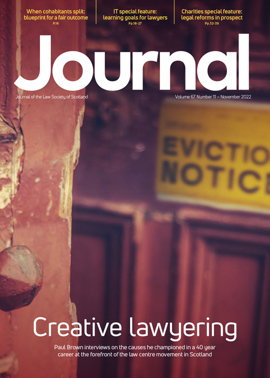In-house: Advisers or leaders?

“From legal advice to legal leadership: how in-house lawyers are driving critical business needs.” This was the theme for the Law Society of Scotland’s in-house stream at the 2022 annual conference. Chaired by Vlad Valiente, head of Governance & Assurance at Dumfries & Galloway Council and co-convener of the In-house Lawyers’ Committee, a panel of three in-house solicitors in senior roles shared their experiences of delivering much more than just black letter law answers for their internal clients.
The session began with introductions from the panel:
 Candice Donnelly: I am the Director of Corporate within the legal team at tech company Skyscanner, where I have worked since March 2020. I’m responsible for everything from leading corporate transactions and managing Skyscanner’s global governance obligations, to advising on the group’s employee share schemes, intellectual property and real estate. I’m fortunate to be part of Skyscanner’s leadership team, which gives me scope to understand and influence the company’s strategy and to support growth of the business going forward.
Candice Donnelly: I am the Director of Corporate within the legal team at tech company Skyscanner, where I have worked since March 2020. I’m responsible for everything from leading corporate transactions and managing Skyscanner’s global governance obligations, to advising on the group’s employee share schemes, intellectual property and real estate. I’m fortunate to be part of Skyscanner’s leadership team, which gives me scope to understand and influence the company’s strategy and to support growth of the business going forward.

Shareen Gault: I’m general counsel, head of Risk & Compliance at accountancy firm Johnston Carmichael. I’m responsible for governance, risk and compliance within the firm, handling its internal legal matters, regulatory compliance and risk management strategy. I’ve held various in-house roles over the past 15 years from legal and compliance manager at a non-departmental public body to GC at an offshore wind company. Despite the obvious differences in sector, the roles have been similar. And I’ve generally been able to go in and shape the type of activities that my role includes.
 Fraser Bell: I’m the interim chief operating officer at Aberdeen City’s Health & Social Care Partnership. Following my traineeship with a large firm, I’ve worked at local authorities in Shetland, Orkney and most recently as chief legal officer at Aberdeen City Council. I’ve recently moved to the COO role and am currently responsible for leading several health and local authority services in Aberdeen. It’s been an exciting time to work at Aberdeen City. The council changed its operating model. That’s allowed me to explore what that means from a governance perspective and put in place proportionate arrangements and good risk management strategies to ensure those operational changes are delivered.
Fraser Bell: I’m the interim chief operating officer at Aberdeen City’s Health & Social Care Partnership. Following my traineeship with a large firm, I’ve worked at local authorities in Shetland, Orkney and most recently as chief legal officer at Aberdeen City Council. I’ve recently moved to the COO role and am currently responsible for leading several health and local authority services in Aberdeen. It’s been an exciting time to work at Aberdeen City. The council changed its operating model. That’s allowed me to explore what that means from a governance perspective and put in place proportionate arrangements and good risk management strategies to ensure those operational changes are delivered.
 VV: What obstacles or hindrances are there for in-house solicitors looking to get into strategic roles?
VV: What obstacles or hindrances are there for in-house solicitors looking to get into strategic roles?
CD: Traditionally, legal teams have been seen as a blocker to getting stuff done. Raising challenges is a fundamental part of the role, but there are certain ways to phrase those questions so that legal gets the reputation of unlocking a project rather than blocking it. In-house solicitors have a really advantageous strategic position: we’re one of the few teams to have a broad overview of the business and we have a key role to play in horizon scanning. However, we’re not always good at celebrating our own successes and, if we want to enable, and benefit from, those cross-functional interactions, we need to change the narrative on that.
FB: It’s also about making clear what you can offer. Organisations have their own set of governance rules. Clearly the legal team’s role sometimes is to say “you need to stick to the rules”. However, as you begin to understand the risk appetite, you can say “maybe it’s time to change the rules, and I can help you do that”.
SG: For me, the only obstacle to getting into that strategic role is yourself. Initially I thought of myself just as the solicitor. I felt I could only comment on matters of law where my advice was being sought. I soon realised that actually it’s okay to step out of your comfort zone and contribute to non-legal aspects of the discussion. Lawyers have great training and transferable skills which frankly can be invaluable in coming up with solutions.
VV: Agreed. As in-house counsel we need to call it as we see it and that, in turn, will build trust with our internal client. However, does the panel see any danger to commenting beyond your brief and that your authority as legal adviser skews decisions in non-legal areas?
CD: No, I’m more concerned about not having a strong enough voice! In-house lawyers should be confident about what they can bring to the table, whether from a legal, commercial or practical perspective, and we should recognise the value of our contribution.
FB: I’ve learned over time that building good relationships with your internal clients is absolutely key. As those relationships develop, so does a strong sense of trust and that makes working with the legal team more attractive. Other service areas aren’t slow to give their opinion. Having the confidence to comment beyond your brief and make suggestions on how to do things differently is really important. If you see scope for improvement, don’t just let it lie – even if it’s nothing to do with the law. There’s great responsibility in that, but also great opportunity. It allows you to shape your role and the part you play in senior management decisions.
VV: Is there any conflict between contributing to strategic decisions and giving dispassionate legal advice? And how do you reconcile the two?
SG: There can be conflict, but I find an effective way of managing that potential tension is to metaphorically wear different hats. My role is really varied, and I do need to differentiate my advice. I’ll often say “the strict legal answer is X, but commercially my advice would be Y”. It’s one of the main differences with working in private practice. Your internal client isn’t looking for a perfectly structured advice note with authorities, they want a succinct view of potential issues and proposed solutions. There are better technical lawyers than me, but my value is often as a problem solver. My colleagues might ask: “What do you think we should do?”, and I’m comfortable to say: “Based on my experience, my knowledge of the law and my commercial understanding – here’s what I would do…”
VV: How should an in-house legal team deal with cost cutting by non-legal managers, and does the panel have any advice on growing an in-house team?
CD: I’m lucky that legal expenditure is already seen as worthwhile by my organisation, but equally we do need to get value for money on external spend. I’ll also consider whether some work is better placed being managed by our procurement or HR colleagues or through an automated process. The legal team needs to think laterally and grasp opportunities to grow. For example, at Skyscanner, we’ve taken on responsibility for sustainability and ESG initiatives – these are growth areas where the legal team can add real value and insight.
FB: We’ve seen over a decade of cuts in local government budgets, so it’s really important for the legal team to be able to demonstrate value and evidence the impact of reducing the number of solicitors. I’ve also had to give careful consideration to what we can stop doing safely – either completely or by giving this to another department. But I think in-house legal has a really bright future. We’re best placed to be the experts on the organisation’s operating environment and to build those essential relationships with our internal clients.
SG: The private sector is also facing pressure on budgets. It has to be about demonstrating value and that’s not just what is saved by what can be done internally versus what is outsourced. As in-house counsel, you are crucial to connecting the dots that might often not be visible if it is legal advice in isolation. But equally, it’s sometimes more efficient to outsource if it’s discreet packageable advice. In terms of growing a team, in my last two roles there was no legal presence before I joined. By the time I left, I’d grown the legal function into larger teams. The only way to make the case to do that is to show what value you’re adding.
VV: In my view, in-house lawyers are the ultimate smoke detectors for their organisations. We’re good at prevention and we need to be able to demonstrate the value in that, even when budgets are tight. If you reach out to your client departments, you’ll soon realise they’re always looking for more support from legal, not less! And that can help you make the case for growing the team.
VV: A final question for the panel: how can you measure the legal team’s value in terms of KPIs?
CD: This is a great question! To some parts of the business, numbers mean a lot, but it often can be difficult to quantify what the legal team does. Developing bespoke metrics and finding different ways to measure legal output can be useful. For example, putting a value on litigation costs avoided or money saved by not outsourcing legal work can help underscore our results from a commercial point of view.
SG: I find that impact stories are useful. The legal role can often be backstage. “Our counsel done well”, is often not visible. If you can demonstrate the impact that your intervention or support has had, that can be a good way of highlighting the legal team’s achievements.
FB: KPIs are something I’ve certainly grappled with. I look at the bigger organisational picture and how much time we’ve spent fixing things that have gone wrong, versus delivering part of a project. The less time spent on unravelling problems, the better the job we’re doing on prevention. I also put the team forward for awards and use that as evidence of our value.
VV: Thank you all for taking part.

Regulars
Perspectives
Features
Briefings
- Civil court: Broad sweep of the sheriff court
- Employment: Support through the cost of living crisis
- Family: Case management rules made for 2023
- Human rights: Protest as a defence to vandalism?
- Pensions: TPR issues auto-enrolment warning
- Property: New lease of life for commercial lets
- In-house: Advisers or leaders?







